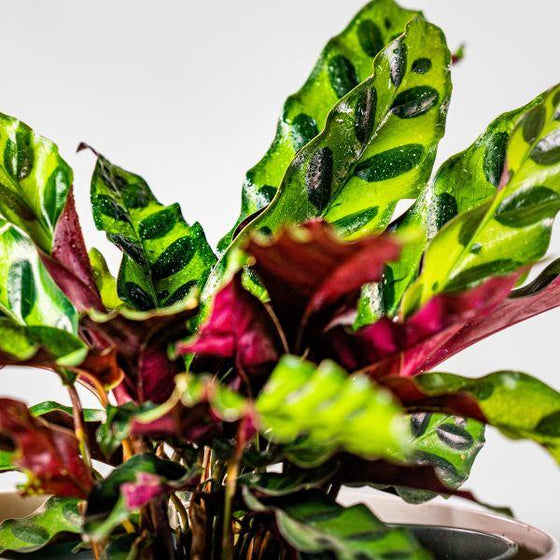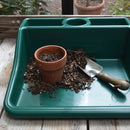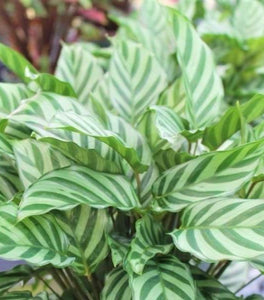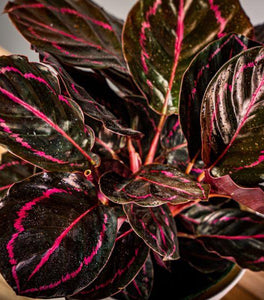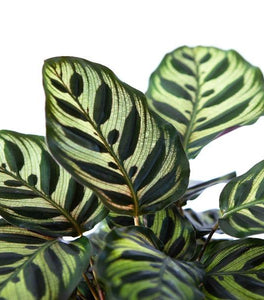
Images Depicted Range in Maturity & Container Size
Pots & Decorations Not Included Unless Otherwise Stated
Rattlesnake Plant: Wavy, Spotted Leaves with a Purple Twist
Brushstroke Patterns and Nightly Leaf Movement
The Rattlesnake Plant (Calathea lancifolia / Goeppertia insignis) is a tropical foliage star with leaves that resemble hand-painted artwork. Long, narrow blades emerge pale green, then fill in with rows of dark green “spots” that resemble reptile markings, while the undersides glow a deep purple. Like other prayer plants, its foliage gently rises and falls throughout the day, adding a sense of quiet movement to shelves, plant stands, and side tables. It’s a plant you’ll find yourself looking at again and again—the pattern is that hypnotic.
Upright, Fountain-Like, and Gracefully Compact
Rattlesnake Plant grows as an upright, clump-forming perennial with leaves that arch outward from a central crown in a fountain-like shape. Indoors, most plants grow to around 18–30 inches tall and wide in a roomy pot, making it substantial enough to fill a corner without dominating the room. The slender leaves and wavy edges give it a lighter, more airy look than broad-leaved Calatheas, so it plays nicely alongside bigger tropicals and trailing vines. Over time, new shoots emerge from the base, thickening the clump into a lush, full specimen.
Filtered Light, Moist Soil, and High Humidity
In nature, this species grows on the rainforest floor of Brazil under a protective canopy, which reveals almost everything about its natural preferences. It thrives in medium to bright indirect light and also tolerates lower-light locations, as long as there’s enough ambient brightness to read by. Direct midday sun can scorch and fade the patterned leaves, so think filtered or dappled light rather than harsh rays.
The roots like consistently moist, well-drained soil—never bone dry, never swampy. Let the top inch of the potting mix dry slightly, then water thoroughly and allow excess to drain away. Calatheas can be sensitive to hard or heavily treated tap water, so filtered, distilled, or rainwater is often recommended to keep leaf edges looking better. High humidity is essential for this plant to thrive: aim for around 50–60% or higher with the help of grouping, pebble trays, or a humidifier.
Pet-Safe Tropical Texture Indoors
Think of Rattlesnake Plant as a designer pattern for your interior “landscape.” Indoors, it’s ideal as a mid-sized focal plant on a plant stand, in a decorative cachepot on the floor, or as the centerpiece of a plant cluster near an east or north window. Its narrow, wavy leaves add delicate texture and visual rhythm that play beautifully against round-leaved plants and trailing species.
One of its most significant advantages is that it’s considered non-toxic to cats and dogs, so it’s a fantastic choice for pet-friendly homes that still want dramatic foliage. In warm, frost-free climates, it can also spend summers outdoors in a shaded, humid spot, then come back inside once the nights cool down.

| Grow Zone: | Grown indoors in most climates; outdoors year-round in frost-free Zones |
|---|---|
| Mature Height: | Typically 18–30" tall |
| Mature Width: | 12–24" wide indoors |
| Classification: | Tropical foliage houseplant |
| Sunlight: | Medium to bright indirect light; tolerates low indirect light; avoid direct sun |
| Flower Color: | Spring; occasional small yellowish flowers—grown mainly for patterned foliage |
| Value: | Generally considered non-toxic to pets and people |
| Soil Condition: | Rich, well-draining potting mix that stays evenly moist but not waterlogged |
| Water Requirements: | Keep soil consistently moist; water when top 1" is dry; prefers filtered or soft water |
| Uses: | Pet-friendly indoor foliage plant, bedroom/bathroom accent, grouped tropical display |
How to Care for Calathea lancifolia / Goeppertia insignis (Rattlesnake Plant)
Please follow our planting and care instructions to keep your rattlesnake calathea healthy and happy

How should I plant Calathea lancifolia (Rattlesnake Plant)?
Choose a container with drainage holes that’s just 1–2 inches wider than the current nursery pot. Rattlesnake Plant prefers to be comfortably snug, not swimming in a giant pot of soil. Fill the bottom with a rich, well-draining potting mix—something based on peat or coco coir with added perlite or fine bark for aeration. Gently slide the plant from its grower pot, loosen any circling roots, and set the root ball so the top sits level with the surrounding soil. Backfill, lightly firm the mix to settle it, and avoid burying the stems too deeply. After planting, water slowly and thoroughly until moisture begins to drain from the bottom, then let the pot drip dry before placing it back on a saucer or into a decorative cachepot. Position your Rattlesnake Plant in medium to bright indirect light—near an east or north window, or a few feet back from a brighter window with filtered sun. Keep it away from hot drafts, cold blasts, or spots where direct midday sun might hit the leaves.
How often should I water Calathea lancifolia after planting?
Right after planting, that initial thorough watering will help eliminate air pockets and settle the roots. From then on, aim for consistently moist but not soggy soil. Let the top inch of the mix dry out slightly between waterings, then water evenly until excess drains away. Using room-temperature filtered or distilled water can help prevent crispy edges, especially in areas with hard or heavily chlorinated tap water. In a typical home, that often translates to watering about once a week during spring and summer, with adjustments based on pot size, temperature, and humidity. In lower light or cooler months, the soil will dry more slowly, so stretch out your schedule and always check the mix before watering. If the leaves curl and the pot feels light, it may be too dry; if they yellow from the base and the soil feels constantly wet, it’s time to back off and let the mix dry a bit longer.
When should I fertilize Calathea lancifolia?
Fertilize Rattlesnake Plant lightly during its active growing season, from spring through early fall. A balanced, water-soluble houseplant fertilizer diluted to half strength every 4–6 weeks is usually plenty. Apply after you’ve watered so nutrients flow through moist soil, which helps prevent root burn and salt buildup. If you prefer a gentler, organic approach, you can top-dress the pot with a thin layer of worm castings in spring and use a diluted organic liquid feed once a month. Avoid heavy or frequent feeding—this plant is more likely to sulk from overfertilizing than from being fed a bit lightly. Pause fertilizing in late fall and winter when growth naturally slows, and resume when you see fresh leaves unfurling again in spring.

When and how should I prune Calathea lancifolia?
Rattlesnake Plant doesn’t need structural pruning, but regular grooming keeps it looking lush and clean. Use sharp, clean scissors to remove yellowed, brown, or torn leaves at their base whenever you notice them. This tidies the plant and encourages it to put energy into fresh foliage. If only the tips or edges of a leaf are browned but the rest looks healthy, you can carefully trim away just the damaged portions, following the natural contour of the leaf so the cut blends in. Do most of your cleanup during the growing season, when the plant can quickly replace old leaves. Keep dust off the foliage by gently wiping with a soft, damp cloth so the leaves can breathe and show off their pattern.


